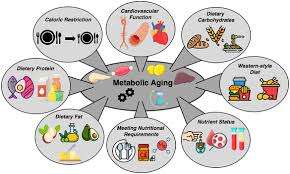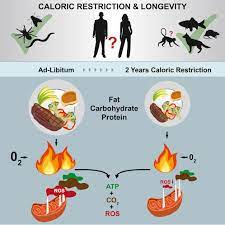Ah, aging—nature’s way of slowing things down, quite literally.
Remember when you could devour an entire pizza without a second thought, but now just glancing at a slice makes the scale inch up?
That’s not just you; it is your metabolism playing tricks as you age.
In this article, we will dive into why your metabolic rate declines with age, what science says, and what you can do to fight back.
In this Article We’ll cover:
- The role of muscle mass and hormonal changes in metabolic decline.
- How physical activity (or the lack of it) impacts your metabolism.
- The influence of diet and lifestyle choices on aging metabolism.
- Real-life examples of how people manage their metabolic rate.
- Practical tips for maintaining a healthier metabolism as you age.
Let’s get into it!
Article Index
- Introduction to Metabolism and Aging
- Muscle Mass and Metabolic Rate
- Hormonal Changes and Their Impact
- Physical Activity and Its Role in Metabolism
- Dietary Habits and Metabolism Over Time
- FAQs on Metabolic Rate Declining with Age
- Conclusion: Fighting Back Against a Slower Metabolism
Introduction to Metabolism and Aging
Metabolism is the process by which your body converts what you eat and drink into energy.
Your Basal Metabolic Rate (BMR) represents the number of calories you burn at rest, keeping your vital functions running. Interestingly, your BMR doesn’t remain static throughout your life.
Studies such as the Science journal study led by Pontzer et al. (2021) show that metabolic rate remains relatively stable from ages 20 to 60 before it starts to decline gradually.
So, why does this happen?
The decline in metabolic rate is influenced by several factors: loss of muscle mass, hormonal shifts, decreased physical activity, and changes in dietary habits.
As we explore each of these, you will see how they collectively impact your metabolic rate.

Muscle Mass and Metabolic Rate
Muscle is your metabolic powerhouse.
It is a tissue that burns calories even when you are doing nothing (yes, just sitting there scrolling through your phone).
As we age, we lose muscle mass—a process known as sarcopenia.
Research published in the Current Opinion in Clinical Nutrition & Metabolic Care by Volpi et al. (2004) indicates that muscle mass declines by about 3-8% per decade after age 30, and this rate accelerates past age 60.
This decline is a major contributor to the drop in your BMR.
Take John, for example, a 50-year-old who used to be quite active in his 30s.
He noticed his metabolism slowing as he became less active and lost muscle mass.
This is not unique to John; the findings from studies like the Science journal’s investigation on energy expenditure reveal a trend where the resting metabolic rate decreases as muscle mass declines.
The connection is simple: less muscle equals fewer calories burned at rest.
Hormonal Changes and Their Impact
Hormones are the silent players in the metabolic game.
As we age, levels of certain hormones such as growth hormone, testosterone (in men), and estrogen (in women) decline.
These hormones are vital for maintaining muscle mass and regulating energy expenditure.
For instance, lower testosterone levels in men can lead to muscle loss, further slowing metabolism, as supported by research from The Journal of Clinical Endocrinology & Metabolism.
Women experience a similar issue with menopause, as reduced estrogen levels can affect how the body stores fat and uses energy.
This hormonal shift contributes to a decline in metabolic rate, often leading to weight gain if lifestyle adjustments are not made.
The Framingham Heart Study supports these observations, noting how hormonal fluctuations significantly impact metabolic functions across different age groups.
>>> Want to Learn How I “Re-Charged My Slow Metabolism” at Home??? Click Here to Find Out!<<<
Physical Activity and Its Role in Metabolism
As we age, a decline in physical activity is a significant factor contributing to a slowing metabolism. This decrease in activity can result from various factors, including busy schedules, physical limitations, or a preference for sedentary activities like watching television.
Reduced physical activity leads to fewer calories burned and an increased risk of muscle loss. The principle of “use it or lose it” is particularly relevant here.
Research indicates that individuals who maintain physical activity into their later years can preserve a higher basal metabolic rate (BMR) compared to their sedentary counterparts.
For example, a study published in Cell Metabolism found that high-intensity interval training (HIIT) can reverse some cellular aspects of aging, enhancing muscle protein content and mitochondrial function, especially in older adults (Source: Mayo Clinic, Mayo Clinic Discovers High-Intensity Aerobic Training Can Reverse Aging Processes in Adults).
Muscle mass plays a crucial role in determining BMR. As muscle mass decreases with age, the body’s resting energy expenditure declines, leading to a slower metabolism.
However, engaging in regular physical activity, particularly strength training exercises such as compound lifts or squats, can help counteract this decline by preserving or increasing muscle mass.
The National Institute on Aging emphasizes that exercise can help older adults maintain muscle mass, which is essential for sustaining a healthy metabolism (Source: National Institute on Aging, What Do We Know About Healthy Aging?).
Incorporating both aerobic and resistance training exercises is beneficial for maintaining a healthy metabolism. Aerobic exercises, such as walking, swimming, or cycling, improve cardiovascular health and aid in calorie burning. Resistance training exercises, like weightlifting or body-weight exercises, build and preserve muscle mass, which is vital for a higher BMR.
The National Institute on Aging recommends that older adults engage in both types of exercises to promote overall health and metabolic function (Source: National Institute on Aging, Health Benefits of Exercise and Physical Activity).
It is also important to note that while BMR accounts for a significant portion of daily energy expenditure, other factors such as diet and overall lifestyle play crucial roles in weight management.
The Mayo Clinic highlights that factors like body size and composition, sex, and age influence BMR, but physical activity is a variable that individuals can modify to boost their metabolism (Source: Mayo Clinic, Metabolism and Weight Loss: How You Burn Calories).
In summary, decreased physical activity with aging contributes to a slowing metabolism, primarily due to muscle loss and reduced energy expenditure.
However, by adopting a consistent exercise routine that includes both aerobic and resistance training, individuals can preserve muscle mass, maintain a higher BMR, and support overall health as they age.
Dietary Habits and Metabolism Over Time
Let’s not forget the role of diet in this equation.
As we age, not only do we need fewer calories, but our food choices may also change.
Older adults often experience reduced appetite or difficulty cooking, leading to less nutritious meals.
This dietary shift can affect metabolism, especially if protein intake is reduced, as protein is crucial for maintaining muscle mass.
A decline in muscle mass, combined with poor dietary habits, leads to a vicious cycle.
The American Journal of Clinical Nutrition notes that without sufficient protein and activity, the average BMR by age significantly drops.
Consider Robert, who retired at 65 and noticed a sudden increase in weight.
After consulting with a nutritionist, he realized his protein intake was insufficient. By adjusting his diet to include more lean proteins and incorporating resistance exercises, he managed to slow down the decline of his BMR.
FAQs on Metabolic Rate Declining with Age
Q-1: If I weigh the same, why does my metabolism still slow with age?
A-1: “Same weight” can hide a quiet shift from muscle to fat and from high-demand organs to lower-demand tissue. A kilogram of liver, brain, heart, or kidney burns far more calories at rest than a kilogram of adipose tissue.
With age, we often lose organ and muscle mass while maintaining or gaining fat mass, so total resting energy use drops even when the scale doesn’t budge.
Q-2: What’s happening at the cellular level that nudges energy use downward?
A-2: Mitochondria—the cell’s power plants—tend to become less efficient at turning fuel into usable energy. Cells also prioritize repair and stress-response pathways over energy-intensive growth and turnover.
That means fewer ATP-hungry processes (like rapid protein synthesis), so baseline calorie needs drift lower even without big changes in daily activity.
Q-3: How do hormones steer this decline?
A-3: Aging usually brings subtler thyroid signaling (especially active T3), lower sex steroids, and a toned-down sympathetic “get up and go” drive. Together, those shifts reduce spontaneous movement, heat production, and the pace of tissue turnover.
Many people notice this as fewer unconscious fidgets, feeling cooler in the same room, or needing less food to feel “warmed up” in winter.
Q-4: Does the immune system play a role in slowing metabolism?
A-4: Yes. Low-grade, chronic inflammation tends to rise with age (“inflammaging”). Immune cells stay more active, but paradoxically the body often becomes more conservative elsewhere—dialing down costly processes and altering how tissues respond to insulin and thyroid cues.
The net effect can be less efficient fuel use and a small, steady drop in resting energy needs.
Q-5: Is it just resting metabolism, or do daily habits amplify the slowdown?
A-5: Both. Resting needs may dip, but lifestyle amplifies the change: fewer high-effort bouts, shorter or lighter workouts, reduced non-exercise movement, and smaller protein intakes all erode muscle quality and “afterburn.”
Sleep fragmentation and circadian drift also reduce daytime pep and spontaneous activity.
The practical antidote is layered: keep protein high enough to protect lean mass, lift weights 2–3 times weekly, accumulate brisk minutes most days, keep a regular sleep schedule, and nudge daylight exposure early—each step helps preserve the “costly” tissues and behaviors that keep metabolism humming.

Fighting Back Against a Slower Metabolism
So, what is the solution to this metabolic slowdown?
You cannot stop aging, but you can take action to mitigate the effects.
Here are some strategies:
- Maintain Muscle Mass: Incorporate resistance and strength training exercises into your routine. Even two days a week can make a difference.
- Prioritize Protein: A protein-rich diet supports muscle maintenance, which is vital for keeping your metabolic rate up.
- Stay Active: Engage in regular physical activity that includes both aerobic exercises (like walking or cycling) and strength training.
- Monitor Hormonal Health: Regular check-ups can help manage hormonal changes that affect metabolism. For some, hormone replacement therapies may be beneficial under medical supervision.
- Mind Your Diet: As you age, focus on balanced meals rich in proteins, whole grains, and vegetables to fuel your body without overloading on calories.
Maintaining a healthy metabolism as you age is not just about keeping the numbers on the scale in check; it’s about staying active, feeling energetic, and supporting overall health.
While your metabolic age chart might suggest slowing down, taking proactive steps can help you keep your BMR stable.
By understanding how your body’s metabolism evolves over time and making lifestyle changes, you can keep the metabolic flames burning brighter, even as the years go by.
References: